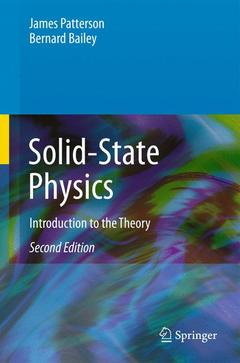Solid-State Physics (2nd Ed., Softcover reprint of the original 2nd ed. 2010) Introduction to the Theory
Auteurs : Patterson James, Bailey Bernard

Learning Solid State Physics involves a certain degree of maturity, since it involves tying together diverse concepts from many areas of physics. The objective is to understand, in a basic way, how solid materials behave. To do this one needs both a good physical and mathematical background. One definition of Solid State Physics is it is the study of the physical (e.g. the electrical, dielectric, magnetic, elastic, and thermal) properties of solids in terms of basic physical laws. In one sense, Solid State Physics is more like chemistry than some other branches of physics because it focuses on common properties of large classes of materials. It is typical that Solid State Physics emphasizes how physics properties link to electronic structure. We have retained the term Solid
Modern solid state physics came of age in the late thirties and forties and is now is part of condensed matter physics which includes liquids, soft materials, and non-crystalline solids. This solid state/condensed matter physics book begins with three broad areas: (1) How and why atoms bind together to form solids, (2) Lattice vibrations and phonons, and (3) Electrons in solids. It then applies these areas to (4) Interactions especially of electrons with phonons, (5) Metals, the Fermi surface and alloys, (6) Semiconductors, (7) Magnetism, (8) Superconductivity, (9) Dielectrics and ferroelectrics, (10) Optical properties, (11) Defects, and (12) Certain other modern topics such as layered materials, quantum Hall effect, mesoscopics, nanophysics, and soft condensed matter.
For this 2nd addition new material has been added on the evolution of BEC to BCS phenomena, conducting polymers, graphene, highly correlated electrons, iron pnictide superconductors, light emitting diodes, N-V centers, nanomagnetism, negative index of refraction, optical lattices, phase transitions, phononics, photonics, plasmonics, quantum computing, solar cells, spin Hall effect, and spintronics.
The major addition to this 2nd edition is an extensive solutions manual, in which all the text problems are discussed. The problems in our book cover a wide range of difficulty. The solutions in this manual are expected to show what we expect to get out of the problems. In the manual, we have also included a brief summary of solid state physics which should help you get focused on problem solving. We have also included "folk theorems" to remind about the essence of the physics without the mathematics.
Date de parution : 08-2016
Ouvrage de 827 p.
15.5x23.5 cm
Thèmes de Solid-State Physics :
Mots-clés :
Potential; alloy; condensed matter; crystal; liquid; magnetism; photonics; plasmonics; polymer; semiconductor; superconductor



